You are using an out of date browser. It may not display this or other websites correctly.
You should upgrade or use an alternative browser.
You should upgrade or use an alternative browser.
Vestments: history and meaning
- Thread starter Paidiske
- Start date
ViaCrucis
Confessional Lutheran
- Oct 2, 2011
- 37,457
- 26,886
- Country
- United States
- Faith
- Lutheran
- Marital Status
- In Relationship
- Politics
- US-Others
It has more to do with Liturgical beauty through presentations of Biblical metaphorical imagery of the Heavenly Kingdom. For the celebrants, the wearing of vestments can oftentimes be a form of physical torture, because when it's very hot in Church, it's extremely hot (and sweaty) inside of the vestments, and difficult to bear. The celebrants bear such discomfort for the sake of the faithful who come to worship God in a place that brings God and His Kingdom into their minds, and their hearts, through all of their physical and spiritual senses.
In all my time as a Lutheran I've never seen the pastor dressed in vestments as indicating "Oh, this person is really, really special because they have fancy clothes", which is the way I was largely taught to think in my pre-Lutheran days. Because the vestments are part of the larger spiritual aesthetic of the liturgy. The colors and symbols that adorn all the physical liturgical elements, such as vestments and paraments, all exist to point the Faithful toward the beauty and truth of our Christian faith. That aesthetic isn't mere trimming, or superfluous "stuff", it's there to serve the as pointers to what we are there to do and receive in the first place.
Of course a pastor or priest could wear a business suit, or dress business casual, or even in street clothes and still do what they are there to do, but frankly I'd find that rather distracting. Such things aren't about Divine Commandment or some such, but about supporting the whole structure of the liturgical celebration, which of course isn't about ourselves or about the officers and ministers playing their roles, but about Jesus Christ. And so the whole of the liturgy, from the deepest and most sacred elements to the aesthetics of it all, all of it is there to draw us toward the whole reason we are there: to meet Jesus Christ in Word and Sacrament.
-CryptoLutheran
Upvote
0
- Nov 26, 2019
- 11,180
- 5,708
- 49
- Country
- United States
- Faith
- Generic Orthodox Christian
- Marital Status
- Celibate
A deacon wears it draped over the left shoulder and fastened at the right hip. A priest wears it draped so that both ends of the stole hang in front.
Deaconwise:
View attachment 247286
Preistwise:
View attachment 247287
Eastern, Syriac Orthodox and Armenian deacons wear their stoles hanging on one side only. I am not entirely sure what keeps it from falling off their shoulder.
Upvote
0
- Nov 26, 2019
- 11,180
- 5,708
- 49
- Country
- United States
- Faith
- Generic Orthodox Christian
- Marital Status
- Celibate
I rather like the symbolism of vestments.
By way of comparison, I attended a Southern Baptist ecclesial community for many years. The lead pastor there was in his lower 50's and typically dressed in jeans and button-up shirts. Obviously we all wear different clothes every day and he was no exception. He left the community some years back and he's been replaced by a different lead pastor who has his own fashion sense. Eventually, this new pastor will be replaced by someone else who also has their own style, etc.
In the Catholic Church though, that's not what happens. My priest wears vestments and the collar. But someday, God will call him home. And my priest will be replaced by a different man, but one who also wears vestments and collar.
These priests come and go, live and die. But their mission, their ordination and their vestments are basically the same and they're done in service to the same God. To me, that's far more beautiful symbolism than the dressed-down, come as you are because we do too approach of that Southern Baptist ecclesial community. And I think it symbolizes the eternal, permanent nature of the Church.
The main sadness is the preponderance of ugly green Gothic chasubles. Roman priests look best with a nice fiddleback chasuble, a matching cope worn during the introit and asperges, a biretta, a maniple, and other acoutrements. And an alb and tunicle or folded chasubles for the deacon and subdeacon.
Upvote
0
- Nov 26, 2019
- 11,180
- 5,708
- 49
- Country
- United States
- Faith
- Generic Orthodox Christian
- Marital Status
- Celibate
the blue vestments are my favorite so far, and by far the most gorgeous
so much must be hand sewn?
Yes, and they can be very expensive. You could, if you wanted a bejewelled mitre with real diamonds, spend $50,000 on one set of vestments for an Eastern Orthodox bishop. On the other hand, Ukrainian and Indian tailors do vestment sets for priests for $200-$450.
Upvote
0
- Nov 26, 2019
- 11,180
- 5,708
- 49
- Country
- United States
- Faith
- Generic Orthodox Christian
- Marital Status
- Celibate
are the Greek Orthodox cassock different colors as well, depending on the ceremony?
A white alb completely covers (or hypothetically replaces perhaps in some parishes if it is very hot) the cassock during the Divine Liturgy, otherwise, no. However, His Beatitude the Patriarch of Romania wears a white cassock. The Syriac Orthodox Patriarch and some of their bishops, except in his presence, will wear red cassocks instead of their usual black cassocks, and I have seen Mar Dinkha IV, R.I.P. the Catholicos of the East, wearing a purple cassock.
Upvote
0
- Apr 25, 2016
- 34,224
- 19,070
- 44
- Country
- Australia
- Faith
- Anglican
- Marital Status
- Married
Eastern, Syriac Orthodox and Armenian deacons wear their stoles hanging on one side only. I am not entirely sure what keeps it from falling off their shoulder.
Velcro!

I jest, I jest. I don't know the answer, although the way it hangs looks very similar to the way a sari hangs over the shoulder, so maybe gravity keeps it in place?
There is a funny story about velcro and vestments, though. Years ago, when I was in college, some of my fellow students were being disparaging about cheap albs which fasten with velcro, but don't last well and over time end up looking kind of tatty. And one of our lecturers chimed in and told us that the family who own the patent for velcro make significant donations to the theological college, so we shouldn't be too quick to complain about the stuff!
Upvote
0
- Nov 26, 2019
- 11,180
- 5,708
- 49
- Country
- United States
- Faith
- Generic Orthodox Christian
- Marital Status
- Celibate
I had no idea there was a vestments thread. This is the kind of stuff I love talking about. 

Upvote
0
- Nov 26, 2019
- 11,180
- 5,708
- 49
- Country
- United States
- Faith
- Generic Orthodox Christian
- Marital Status
- Celibate
Velcro!
I jest, I jest. I don't know the answer, although the way it hangs looks very similar to the way a sari hangs over the shoulder, so maybe gravity keeps it in place?
There is a funny story about velcro and vestments, though. Years ago, when I was in college, some of my fellow students were being disparaging about cheap albs which fasten with velcro, but don't last well and over time end up looking kind of tatty. And one of our lecturers chimed in and told us that the family who own the patent for velcro make significant donations to the theological college, so we shouldn't be too quick to complain about the stuff!
Thats a good one!
So I think its better when constrained to spend money on one’s cassock and a single elegant set of starter vestments that aren’t too expensive, vs. buying a cheap cassock and going wild with externals.
In the UCC the three main styles are albs and stoles, academic dress, and Geneva gowns (with some beautiful green and white preaching tabs ... which I want ... in the Hungarian Reformed church in Long Beach, for instance; I need to find out where to get that kind of ornate Continental preaching tab so I can out-Wesley John Wesley). That said I have snuck a chasuble, and with the new church plant I intend to use a cope or chasuble (following in the former case the Assyrian tradition of wearing a cope during the liturgy) at all Eucharistic services, or both. Whereas a cassock, surplice and tippet is what I would most like to wear for non-Eucharistic services.
Right now, I have much of this, but no surplice or tippet. If I had been an altar server in a Catholic church that would really pay off right now.
Upvote
0
Velcro!
I jest, I jest. I don't know the answer, although the way it hangs looks very similar to the way a sari hangs over the shoulder, so maybe gravity keeps it in place?
There is a funny story about velcro and vestments, though. Years ago, when I was in college, some of my fellow students were being disparaging about cheap albs which fasten with velcro, but don't last well and over time end up looking kind of tatty. And one of our lecturers chimed in and told us that the family who own the patent for velcro make significant donations to the theological college, so we shouldn't be too quick to complain about the stuff!
Why not Velcro?
One of my sainted pastors had this stitched to the back of his Cassock and the corresponding portion on the stole to keep it from slipping one way or the other.

Upvote
0
This site stays free and accessible to all because of donations from people like you.
Consider making a one-time or monthly donation. We appreciate your support!
- Dan Doughty and Team Christian Forums
GreekOrthodox
Psalti Chrysostom
- Oct 25, 2010
- 4,121
- 4,191
- Country
- United States
- Faith
- Eastern Orthodox
- Marital Status
- Married
Eastern, Syriac Orthodox and Armenian deacons wear their stoles hanging on one side only. I am not entirely sure what keeps it from falling off their shoulder.
Its the way it is wrapped, it comes from the back and over the shoulder, diagonally to the waist, back up and over the front shoulder.
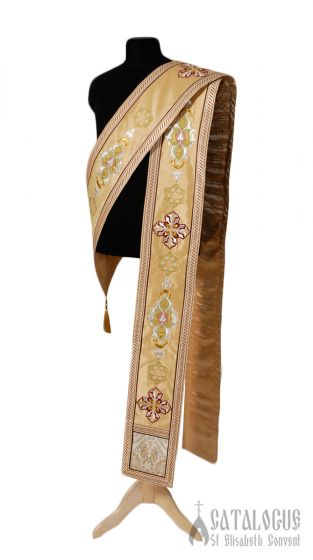
Upvote
0
- Nov 26, 2019
- 11,180
- 5,708
- 49
- Country
- United States
- Faith
- Generic Orthodox Christian
- Marital Status
- Celibate
Its the way it is wrapped, it comes from the back and over the shoulder, diagonally to the waist, back up and over the front shoulder.

Forgive me, I got confused here, despite having not seen a Syriac or Armenian deacon ... for a while, while having very recently attended an EO service with a deacon. So what I said applies only to the Armenian and Syriac churches.
Since the subject of Oriental Orthodox vestments is interesting and I am a vestment nerd, I will share some photos and provide a detailed explanation. Except for how the deacons keep their stoles on; that remains a mystery!
Here is an Armenian deacon, to the right of the two priests, who is wearing a dark red stole, descending vertically unlike an EO deacon. My understanding, which @Pavel Mosko might confirm for us, is that lower ranking Armenian clergy simply wear the dalmatic or tunicle sort of vestment we can see on the altar servers and the deaconess. Notice also the priestly vestments closely resemble Eastern Orthodox vestments. I have heard that the designation “stole bearer” along with this same stole, worn on the other side, is granted to some long serving altar servers who are not trained for the special ministry of the typical diaconate (they basically function as male choristers, like the “gentleman clerks” of some Anglican churches like the Chapel Royal and Westminster Abbey, as distinct from the choir of boys, which function as boarding schools; compare the Latin equivalents for choir and clerks or Psaltis those being Scholae and Cantores)
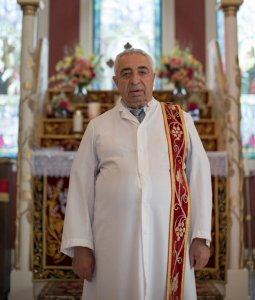
Here is a Syriac Orthodox full deacon, Deacon Shamosho, from a Levantine/Iraqi/Aramaean (Suroyo) parish in the North Eastern US. Notice how his dalmatic goes over one shoulder only.
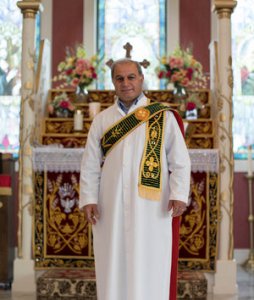
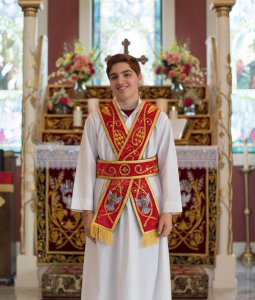
For comparison, here is a Syriac Orthodox subdeacon from the same parish, Deacon John, alomg with Reader Gregorios. Psaltis, who are usually boys, wear just the white alb. Syriac Deacons do not wear Dalmatics.
Syriac deacons are not referred to as “Father Deacon” and have more restricted duties than EO deacons or Armenian deacons, and often in Suroye parishes promotion from Psalti to Reader, Subdeacon and Deacon is partially based on seniority, also partially based on singing ability (a major requirement for Coptic and Syriac priests, who chant more than any clergy in other churches, as @dzheremi can attest); I believe they can also marry in at least the Malankara Orthodox Syrian Church, whereas in that same church, and the other two Syriac Orthodox jurisdictions (there is a silly three way schism among the Nasrani Syriac Orthodox of the Malabar Coast in India, due to a leadership dispute): the Malankara Independent Syrian Church, which is the one in communion with the Anglican Mar Thoma Syrian Church @Paidiske, and in the Syriac Orthodox Patriarchate of Antioch, only monks or married men are ordained to the priesthood.
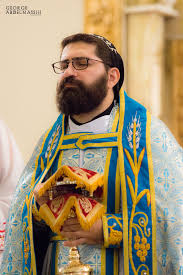
In contrast, the Eucharistic vestments of a Syriac Orthodox priest and those of a bishop (which are basically the same) look like those of Eastern Orthodox clergy.
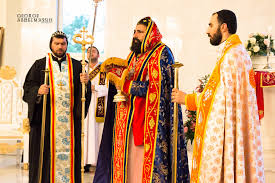
This picture, showing a bishop (center) flanked by two priests, shows there are no liturgical colors, except black choir dress is worn in Holy Week. Thus two priests or one priest and a bishop often wear different colored vestments, which has a beautiful visual effect. Sometimes an assisting priest will also wear black choir dress, which you can see on the priest on the left. I have also seen priests dispense communion after the dismissal, during and after the singing of the beautiful hymn “Haw Nurone”, having already changed back into choir dress. They will remove the simple Byzantine epitrachelion-like stole when not officiating in any capacity. These stoles, both the choir dress form and the more ornate Eucharistic variety, are called “Hamnikho” in Syriac, meaning necklace. A complete guide to Syriac Eucharistic vestments can be found here, demonstrated by His Eminence Archbishop Eugene Kaplan of the Western US: Vestments Noteworthy are the ornate liturgical slippers worn by priests and bishops. Priests also wear their Phiro at all times, and bishops, their eskimo.
The only Oriental Orthodox church with liturgical colors is the Coptic church, where Readers wear black or blue stoles during Holy Week and red stoles on other occasions. Coptic psalti and reader’s stoles are usually reversible, red on one side, and dark blue on the other, and tend to be very long due to the elaborate patterns they are placed in. In contrast tne stoles and epitrachelia of deacons, priests and bishops (a bishop is in the center of the photograph above), are obviously not reversible and are of a finer quality, as are their albs, which are worn over cassocks rather than street clothes.
In the previous photo (with the red stoles usually worn), you can also see the rare Coptic full deacon, who wears a white skullcap at all times, and a stole in the Byzantine manner.
The second photo depicts clergy of St. George’s Mission in the UK, formerly a part of the British Orthodox Church before Metropolitan Seraphim of Glastonbury made a personal decision to become an episcopi vagante with no parishioners. That is a nasty story; I am friends with a St. George’s, ex-BOC priest, Fr. Peter Farrington, and the actions of Metropolitan Seraphim did a lot of damage and caused many BOC members to leave. But enough with sordid ecclesiastical politics, back to the vestments!
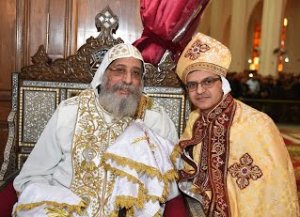
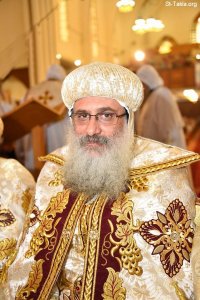
Coptic priests in theory should wear a cope/phelonion/chasuble but in practice this is rare (the older priest in white not wearing one is a hieromonk, or monastic priest; also I have heard the current style of mitre was introduced under Pope Shenouda, RIP. Bishops usually do wear a cope, however (on the right).
Ethiopian vestments are complex and warrant their own post, by someone who knows more about some of tne specific types of vestments (they might also use liturgical colors, I just don’t know; Ethiopian Christianity is obscure (the whole liturgy of the Coptic church is available on an app called CopticReader, in English, Coptic and Arabic, while there are many Ethiopian liturgical manuscripts sitting in monasteries that are barely known to the outside world, let alone translated into English).
Upvote
0
- Nov 26, 2019
- 11,180
- 5,708
- 49
- Country
- United States
- Faith
- Generic Orthodox Christian
- Marital Status
- Celibate
Why not Velcro?
One of my sainted pastors had this stitched to the back of his Cassock and the corresponding portion on the stole to keep it from slipping one way or the other.
Because, dude, its velcro. Although if it worked for your pastor, then I can’t complain. But in most cases, a properly fastened girdle will secure a Western style stole, and from the back, the way the collar of a well fitted stole sits on the alb should make it stay put, for most people. A chasuble or better yet a cope provides an additional advantage of covering up the posterior side of the vestments, which could prevent a vast array of embarassing incidents, unless the cope slips on you shoulders, in which case...velcro.
But vestment fabric is often very fragile embroidered silk, handmade; I would worry about it tearing with velcro, so I would try anything to avoid using velcro or a safety pin on anything expensive.
Upvote
0
- Oct 4, 2016
- 7,236
- 7,313
- 56
- Country
- United States
- Faith
- Oriental Orthodox
- Marital Status
- Single
My understanding, which @Pavel Mosko might confirm for us, is that lower ranking Armenian clergy simply wear the dalmatic or tunicle sort of vestment we can see on the altar servers and the deaconess. Notice also the priestly vestments closely resemble Eastern Orthodox vestments. I have heard that the designation “stole bearer” along with this same stole, worn on the other side, is granted to some long serving altar servers who are not trained for the special ministry of the typical diaconate (they basically function as male choristers, like the “gentleman clerks” of some Anglican churches like the Chapel Royal and Westminster Abbey, as distinct from the choir of boys, which function as boarding schools; compare the Latin equivalents for choir and clerks or Psaltis those being Scholae and Cantores)
That sounds right based on observation etc. rather than knowing or remembering the formal rubrics. There was actually a good Eastern Catholic tomb dating back to the 1920s from the Vatican Counsels Eastern Catholic department that really documented all the rubrics of vestments and rite. Their was some obvious Latinization of some of the rites using the Roman waffer, (where that was implemented earlier) but they did their best to keep to the authentic tradition of each specific Church. I've seen that book in some public libraries and was in the library of a Catholic Seminary, that rented space to Fuller Theological Seminary in Northern California.
@ArmenianJohn is probably your best bet. He seems to spend much his time talking politics and current events but maybe he will see this shout out.
Upvote
0
GreekOrthodox
Psalti Chrysostom
- Oct 25, 2010
- 4,121
- 4,191
- Country
- United States
- Faith
- Eastern Orthodox
- Marital Status
- Married
Forgive me, I got confused here, despite having not seen a Syriac or Armenian deacon ... for a while, while having very recently attended an EO service with a deacon. So what I said applies only to the Armenian and Syriac churches.
View attachment 268600
Here is a Syriac Orthodox full deacon, Deacon Shamosho, from a Levantine/Iraqi/Aramaean (Suroyo) parish in the North Eastern US. Notice how his dalmatic goes over one shoulder only.
I'm wondering if he just has it over one shoulder for the picture and that he holds it in some manner during the service. Either that or it is held by his angel
Upvote
0
This site stays free and accessible to all because of donations from people like you.
Consider making a one-time or monthly donation. We appreciate your support!
- Dan Doughty and Team Christian Forums
- Nov 26, 2019
- 11,180
- 5,708
- 49
- Country
- United States
- Faith
- Generic Orthodox Christian
- Marital Status
- Celibate
I'm wondering if he just has it over one shoulder for the picture and that he holds it in some manner during the service. Either that or it is held by his angel
I have sat through their services. They stay there even when flapping about while they walk. I vote for the angelic option myself.
Upvote
0
ArmenianJohn
Politically Liberal Christian Fundamentalist
- Jan 30, 2013
- 8,962
- 5,551
- Country
- United States
- Faith
- Oriental Orthodox
- Marital Status
- Single
- Politics
- US-Democrat
Hey Liturgist, that's a pretty good summary! Informative! Thanks to @Pavel Mosko for the shout-out also!Forgive me, I got confused here, despite having not seen a Syriac or Armenian deacon ... for a while, while having very recently attended an EO service with a deacon. So what I said applies only to the Armenian and Syriac churches.
Since the subject of Oriental Orthodox vestments is interesting and I am a vestment nerd, I will share some photos and provide a detailed explanation. Except for how the deacons keep their stoles on; that remains a mystery!
View attachment 268615
Here is an Armenian deacon, to the right of the two priests, who is wearing a dark red stole, descending vertically unlike an EO deacon. My understanding, which @Pavel Mosko might confirm for us, is that lower ranking Armenian clergy simply wear the dalmatic or tunicle sort of vestment we can see on the altar servers and the deaconess. Notice also the priestly vestments closely resemble Eastern Orthodox vestments. I have heard that the designation “stole bearer” along with this same stole, worn on the other side, is granted to some long serving altar servers who are not trained for the special ministry of the typical diaconate (they basically function as male choristers, like the “gentleman clerks” of some Anglican churches like the Chapel Royal and Westminster Abbey, as distinct from the choir of boys, which function as boarding schools; compare the Latin equivalents for choir and clerks or Psaltis those being Scholae and Cantores)
View attachment 268600
Here is a Syriac Orthodox full deacon, Deacon Shamosho, from a Levantine/Iraqi/Aramaean (Suroyo) parish in the North Eastern US. Notice how his dalmatic goes over one shoulder only.
View attachment 268602 View attachment 268605
For comparison, here is a Syriac Orthodox subdeacon from the same parish, Deacon John, alomg with Reader Gregorios. Psaltis, who are usually boys, wear just the white alb. Syriac Deacons do not wear Dalmatics.
Syriac deacons are not referred to as “Father Deacon” and have more restricted duties than EO deacons or Armenian deacons, and often in Suroye parishes promotion from Psalti to Reader, Subdeacon and Deacon is partially based on seniority, also partially based on singing ability (a major requirement for Coptic and Syriac priests, who chant more than any clergy in other churches, as @dzheremi can attest); I believe they can also marry in at least the Malankara Orthodox Syrian Church, whereas in that same church, and the other two Syriac Orthodox jurisdictions (there is a silly three way schism among the Nasrani Syriac Orthodox of the Malabar Coast in India, due to a leadership dispute): the Malankara Independent Syrian Church, which is the one in communion with the Anglican Mar Thoma Syrian Church @Paidiske, and in the Syriac Orthodox Patriarchate of Antioch, only monks or married men are ordained to the priesthood.
View attachment 268610
In contrast, the Eucharistic vestments of a Syriac Orthodox priest and those of a bishop (which are basically the same) look like those of Eastern Orthodox clergy.
View attachment 268611
This picture, showing a bishop (center) flanked by two priests, shows there are no liturgical colors, except black choir dress is worn in Holy Week. Thus two priests or one priest and a bishop often wear different colored vestments, which has a beautiful visual effect. Sometimes an assisting priest will also wear black choir dress, which you can see on the priest on the left. I have also seen priests dispense communion after the dismissal, during and after the singing of the beautiful hymn “Haw Nurone”, having already changed back into choir dress. They will remove the simple Byzantine epitrachelion-like stole when not officiating in any capacity. These stoles, both the choir dress form and the more ornate Eucharistic variety, are called “Hamnikho” in Syriac, meaning necklace. A complete guide to Syriac Eucharistic vestments can be found here, demonstrated by His Eminence Archbishop Eugene Kaplan of the Western US: Vestments Noteworthy are the ornate liturgical slippers worn by priests and bishops. Priests also wear their Phiro at all times, and bishops, their eskimo.
View attachment 268616
The only Oriental Orthodox church with liturgical colors is the Coptic church, where Readers wear black or blue stoles during Holy Week and red stoles on other occasions. Coptic psalti and reader’s stoles are usually reversible, red on one side, and dark blue on the other, and tend to be very long due to the elaborate patterns they are placed in. In contrast tne stoles and epitrachelia of deacons, priests and bishops (a bishop is in the center of the photograph above), are obviously not reversible and are of a finer quality, as are their albs, which are worn over cassocks rather than street clothes.
View attachment 268619
In the previous photo (with the red stoles usually worn), you can also see the rare Coptic full deacon, who wears a white skullcap at all times, and a stole in the Byzantine manner.
The second photo depicts clergy of St. George’s Mission in the UK, formerly a part of the British Orthodox Church before Metropolitan Seraphim of Glastonbury made a personal decision to become an episcopi vagante with no parishioners. That is a nasty story; I am friends with a St. George’s, ex-BOC priest, Fr. Peter Farrington, and the actions of Metropolitan Seraphim did a lot of damage and caused many BOC members to leave. But enough with sordid ecclesiastical politics, back to the vestments!
View attachment 268620 View attachment 268621
Coptic priests in theory should wear a cope/phelonion/chasuble but in practice this is rare (the older priest in white not wearing one is a hieromonk, or monastic priest; also I have heard the current style of mitre was introduced under Pope Shenouda, RIP. Bishops usually do wear a cope, however (on the right).
Ethiopian vestments are complex and warrant their own post, by someone who knows more about some of tne specific types of vestments (they might also use liturgical colors, I just don’t know; Ethiopian Christianity is obscure (the whole liturgy of the Coptic church is available on an app called CopticReader, in English, Coptic and Arabic, while there are many Ethiopian liturgical manuscripts sitting in monasteries that are barely known to the outside world, let alone translated into English).
Here's the best I can share - this site lays it all out pretty well:
Church Vestments - St. George Armenian Church
I just wish they had pictures. But if you google any of the armenian vestment terms you'll find images of them for the most part.
i think that the main interesting vestments to most would be the different hats that are used: first and especially the veghar (black hooded hat) and then the khouyr mitred hat and the Saghavard "crown" hat.
The saghavard (crown) is used by all priests and bishops during certain parts of liturgies and other services. It would look like what a lot of Orthodox priests might wear.
The khouyr (mitre) is also used by priests and bishops during liturgy. This would resemble Roman Catholic headwear to most people.
The veghar (black hood) is uniquely Armenian (although a couple churches like Syrian/Syriac might have something similar, but still different). It has more than on meaning but a main one is to represent Ararat which is a national symbol for Armenians. this is the most distinct part of Armenian clerical vestments and most distinguishing. It is as old as the Church - we can see ancient drawings and paintings of Armenian clergy wearing it. It is worn by celibate clergy and I believe it began as a monastic vestment and still has a monastic connotation to it. Married clergy would go bare-headed rather than wear this hood. But for anyone who has seen an Armenian priest/bishop and recognized him as such it's usually because they see this headwear. Here are the two Catholicoi of the Armenian Church in this headwear and in the background you see a couple other bishops or priests also wearing it:
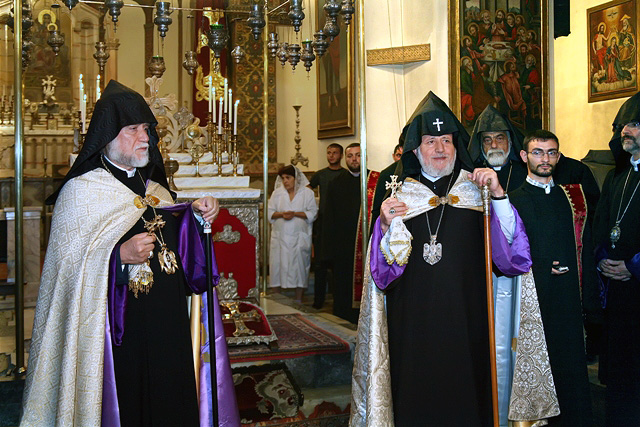
A couple other interesting things to note about the Armenian Church...
Despite being 'Oriental Orthodox', our Church does not call itself "Orthodox" as part of our name. Our name is "Armenian Apostolic Church", we never call ourselves "Armenian Orthodox" Church or people. However, we consider ourselves "Orthodox" as in "right faith", so we don't dislike the term and we accept it but it is not our official name and we call ourselves "Apostolic" instead.
Also, of all the Orthodox Churches (both Oriental and Eastern), we are probably the one that is most like the Roman Catholic Church in many ways. Of course there are Armenian Catholics also, but a small amount. Still, we tend to be a little more Roman Catholic-like than most other Orthodox Churches.
Hope that helps! The link I provided above should be especially helpful!
Upvote
0
GreekOrthodox
Psalti Chrysostom
- Oct 25, 2010
- 4,121
- 4,191
- Country
- United States
- Faith
- Eastern Orthodox
- Marital Status
- Married
I have sat through their services. They stay there even when flapping about while they walk. I vote for the angelic option myself.
When our deacon was adjusting his orarion (stole), I saw that the stole has a fabric loop that attaches to a cloth button sewn onto the alb.
Upvote
0
- Nov 26, 2019
- 11,180
- 5,708
- 49
- Country
- United States
- Faith
- Generic Orthodox Christian
- Marital Status
- Celibate
When our deacon was adjusting his orarion (stole), I saw that the stole has a fabric loop that attaches to a cloth button sewn onto the alb.
That makes sense, because even with the loop, it could fall off. Also, that loop looks like a pain to set in place. I think I have been to at least one Orthodox church, an OCA parish, where the deacon had his stole hang straight down.
Upvote
0
This site stays free and accessible to all because of donations from people like you.
Consider making a one-time or monthly donation. We appreciate your support!
- Dan Doughty and Team Christian Forums
Similar threads
- Replies
- 1
- Views
- 139
- Replies
- 8
- Views
- 378
- Replies
- 2
- Views
- 97
- Replies
- 5
- Views
- 384
